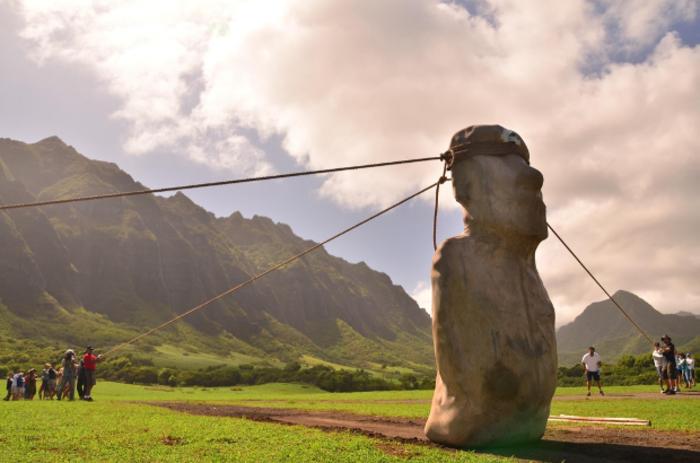For decades, the awe-inspiring moai statues of Rapa Nui have captivated the imagination of archaeologists and casual observers alike, sparking debates on how these enormous stone figures were relocated across the island. Recent research spearheaded by Binghamton University anthropologist Carl Lipo, in collaboration with the University of Arizona’s Terry Hunt, presents a groundbreaking explanation supported by sophisticated 3D modeling, rigorous physics analysis, and controlled field experiments. Their work compellingly demonstrates that the moai statues were moved upright using a carefully orchestrated rocking and “walking” maneuver, facilitated by ropes and coordinated human effort.
The challenge facing previous theories was to elucidate how the ancient Rapa Nui people transported these statues, some exceeding several tons, without the use of modern machinery. Earlier hypotheses posited that the statues were laid flat on wooden sleds or rollers for dragging. However, Lipo and his team proposed an alternative mechanism inspired by the statues’ distinctive structural features — particularly their broad, D-shaped bases and forward-inclined stances. These features, they argued, enabled the statues to pivot from side to side, mimicking a walking motion along the island’s pathways.
To validate this hypothesis from a physics standpoint, the researchers developed high-resolution three-dimensional digital models of nearly 1,000 moai statues, capturing subtle morphological variations. Computational simulations incorporated principles of rotational dynamics and human load distribution, showing that a controlled, rocking zig-zag motion could be sustained with relatively few individuals applying directional force via ropes. This movement reduces friction and distributes stress more efficiently than dragging the statues prone, suggesting a surprisingly energy-conserving method that could maintain momentum over long distances.
Crucially, the team transitioned their findings from virtual to physical by constructing a 4.35-ton replica moai statue, accurately reflecting the key forward-leaning geometry identified in the models. This experimental approach replicated historical scenarios under controlled conditions. With a team of only 18 people, the replica was successfully “walked” 100 meters in just 40 minutes, an outcome that significantly outperformed earlier experimental attempts relying on vertical transport techniques. Their observations emphasize the role of the intrinsic statue design in facilitating locomotion rather than relying on external conveyances.
Complementing their mechanical demonstrations is the integration of archaeological context — the island’s roads themselves. Rapa Nui’s ancient roadways, carefully engineered with a width of approximately 4.5 meters and a distinctive concave cross-section, would have provided the perfect physical substrate to stabilize the moai during their forward rocking motion. These concavities apparently guided the statues, preventing lateral tipping and ensuring balance throughout transport, hinting at holistic planning that married landscape engineering with statue mobility.
Lipo reflects on the ease of the method once the motion is initiated: “Once you get it moving, it isn’t hard at all – people are pulling with one arm. It conserves energy, and it moves really quickly.” This elegant solution syncs perfectly with known cultural and material constraints — limited manpower, absence of draft animals, and primitive yet effective rope technologies — and argues against the need for extraordinary technological interventions.
The study’s physics-based approach stands out by addressing previous skepticism, which criticized walking hypotheses as fanciful or insufficiently supported by empirical data. By blending archaeological scrutiny with state-of-the-art computational and experimental techniques, the work sets a new standard for validating anthropological theories scientifically. Their paper, “The Walking Moai Hypothesis: Archaeological Evidence, Experimental Validation, and Response to Critics,” published in the Journal of Archaeological Science, systematically tackles objections and consolidates the walking model as a parsimonious explanation.
Significantly, this research contributes not only to our understanding of moai transportation but also serves as a broader example of how interdisciplinary methodologies can unravel complex prehistoric engineering feats. The success of the walking technique scales with statue size, making it the most feasible method for moving the largest moai across rugged terrain, disproving assertions that only simpler methods could be deployed. It reveals the innovative ingenuity of the Rapa Nui civilization and their intimate mastery of physics well before formal scientific principles were codified.
Furthermore, this investigation honors the cultural legacy of Rapa Nui, countering sensationalist or unfounded speculations with rigorous science. “It shows that the Rapa Nui people were incredibly smart. They figured this out,” declares Lipo, emphasizing that what was once dismissed as impossible is grounded in smart engineering adapted to their environmental and technological realities. The findings celebrate the legacy of a civilization that engineered monumental objects with remarkable precision and skill using available materials and knowledge.
Beyond its archaeological implications, the research has the potential to inspire modern engineering principles, particularly in low-energy transport methods and the use of natural mechanical advantages in moving heavy loads. This rediscovery of ancient techniques underscores human creativity and resilience and suggests that age-old solutions still hold valuable lessons for contemporary challenges in sustainable and resource-limited engineering.
As Lipo invites critics to disprove the walking hypothesis, the conversation around Rapa Nui moai transport evolves dynamically. Until alternative mechanisms grounded in empirical evidence emerge, the walking model remains the most compelling, unifying theory, blending scientific rigor with respect for indigenous ingenuity. This landmark study exemplifies how bridging digital technology with fieldwork revitalizes the field of archaeology, transforming enigmatic mysteries into intelligible narratives rooted in demonstrable phenomena.
The walking moai phenomenon is not merely an archaeological curiosity but a testament to the profound capabilities of ancient societies. It shifts the paradigm from viewing these statues as immobile monoliths to active participants in Rapa Nui’s cultural landscape, demanding reconsideration of both historical interpretation and public fascination. As science continues to illuminate their secrets, the moai statues stand not just as silent witnesses of the past but as vibrant symbols of human inventiveness and adaptation.
Subject of Research: Not applicable
Article Title: The walking moai hypothesis: Archaeological evidence, experimental validation, and response to critics
News Publication Date: 4-Oct-2025
Web References: http://dx.doi.org/10.1016/j.jas.2025.106383
Image Credits: Carl Lipo
Keywords: Archaeology, Anthropology, Archaeological sites, Experimental archaeology, Historical archaeology, Physics, Computational physics, Computational mechanics, Engineering




